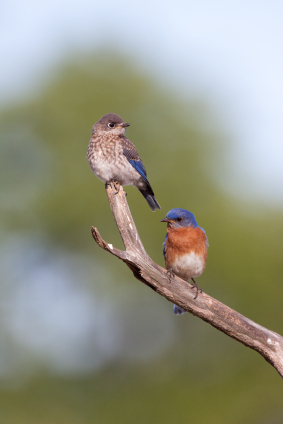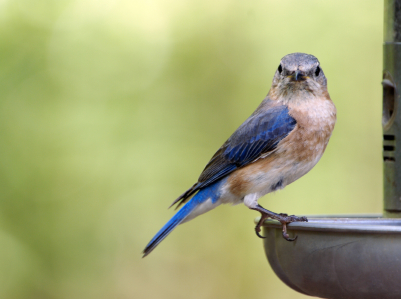-
Bluebird Houses in the News: Proven Beneficial
It’s difficult to convince folks sometimes, and all the blogging in the world may not make a bit of difference. But when the Associated Press does an article on the benefits of backyard birding…it seems a bit more substantial. Bluebird houses have been proven beneficial in the fight against unwanted insects. Much better than ineffective pesticides, most of which have been rendered useless….read on!
DEAN FOSDICK
This Jan. 23, 2005 photo shows an Eastern bluebird photographed near McLeansville, N.C. Eastern bluebirds are voracious insect feeders, especially during nesting and rearing periods. Their primary diet includes flies, katydids, beetles, worms and spiders. They’re aerialists, catching insects on the fly or pouncing on them on the ground. (AP Photo/Dean Fosdick)
Growers are beginning to understand that common birds can be of uncommon value to fields, lawns and gardens.
Many avian species earn their keep by eating insects and small mammals, and destroying weed seeds.
“Commercial growers are turning to birds as an alternative or supplement to pesticides,” said Marion Murray, an Integrated Pest Management project leader with Utah State University Cooperative Extension. “But you have to have the environment or habitat before inviting them in.”
That means mimicking nature by providing plenty of food, water and cover. Put up some bluebird boxes or nest boxes for raptors, said Marne Titchenell, a wildlife specialist with Ohio State University Extension.
“Monitor the bluebird boxes so sparrows don’t take over,” she said. “Brushier habitat provides protection for insect-eating songbirds. Allow the edges of your woodlot to grow up a bit. Berry-producing shrubs are excellent things to have around for all kinds of wildlife.”
Birds occupy a unique place in nature, according to the authors of a timeless 1912 study, “Red Bird, Green Bird: How Birds Help Us Grow Healthy Gardens,” by Harry A. Gossard and Scott G. Harry (Ohio State University Extension, revised edition 2009). “Each species performs a service which no other can so well accomplish,” the authors said.
Raptors such as hawks and owls chase down field mice, moles and grasshoppers. Insectivores like bluebirds, chickadees and woodpeckers stalk beetles, worms and grubs.
Meadowlarks are ground feeders, favoring meadows and farm fields where they gorge on grasshoppers and weevils. Robins focus on lawns and gardens, where they pull up cutworms, wireworms and other larvae injurious to crops.
Chickadees are birds of the forest, eating tent caterpillars, bark beetles and plant lice. Goldfinches prefer open country where they can pursue caterpillars and flies. “No other bird destroys so many thistle seeds,” the authors say.
“An individual tree swallow, barn swallow, purple martin or chimney swift can eat up to a thousand flying insects a day,” said David Bonter, assistant director of Citizen Science with the Cornell Lab of Ornithology. “They can have a big impact.”
While it’s great to have these specialized bug hunters around if you’re a grain farmer, small commercial farmer or orchard grower, recruiting should be directed toward a variety of species, said Margaret Brittingham, a professor of wildlife resources at Penn State University.
“All insect eaters feed at different heights, on different plants and prefer different insects,” she said. “Having some (bird) diversity is important in maintaining insect populations. What we don’t want to wind up with is having a monoculture with birds as we frequently do with plants, inviting problems.”
___
Online:
For more about birds for alternative pest management, see this Utah State University fact sheet http://utahpests.usu.edu/htm/utah-pests-news/fall-09/
You can contact Dean Fosdick at deanfosdick(at)netscape.net
-
Blue Bird Houses May Not be Enough
Silly me! I seriously thought that by placing blue bird houses in the yard the sweet birds would just appear and decide to take up residence. Not the case though. After some time, the bluebird feeder was introduced with offerings that weren’t too enticing to bluebirds. Suet crumbles, bluebird banquet, roasted mealworms, and a host of other foods claiming to be” their favorite” were not attracting bluebirds to the yard.
Then after biting the bullet so to speak, live meal worms were offered and it worked…in fact, it worked great! I noticed in the dead of winter there were eastern bluebirds in my yard…everyday! There’s a heated bird bath in the back, and they frequented it daily. Now added to the list of chores was feeding the worms everyday, but it was just so rewarding to watch these sweet little birds chowing down!
When it started to warm up, the bluebirds were busy building a nest of pine needles in one of blue bird houses. In and out for a few days, the nest was completed quickly. I watched the process over the next few we
eks, afraid to even open the house and peek inside. The parents dutifully fed the chicks mealworms over the next few days. Feeder to house, house to feeder, I watched in delight.
Fledglings! Three healthy bluebird chicks learned to fly. I watched as they’d follow their parents over to the meal worm feeder, land on top and scream for food. After a few days they learned to enter and exit the openings to get their own worms. This was very cool to witness, and I would suggest to anyone with the least bit of interest in Bluebirds to try it and see!
- Bird Accessories, Bird Houses, Blue Bird Houses, Bluebird Houses, Decorative Bird Houses, Uncategorized, Unique Birdhouses
Copper Roof Bluebird Houses-Guaranteed to Last!
Weathered wood is always lovely, until it starts to disintegrate. This happens to many a birdhouse and feeder over time. But these new vinyl bluebird houses are better than wood, and guaranteed to last a lifetime with little to no maintenance.
In classic, architectural styles, they offer your choice of patina or bright copper roof. The vinyl is PVC, just like the siding on people’s homes, and each piece is made to order. They’re complete with a vinyl sleeve post that has attached decorative brackets and fits on a standard 4×4 post.
These great bluebird houses range from a six-inch diameter, up to a ten-inch model. Larger sizes with multiple compartments are available, but not geared towards bluebirds.
The secret to attracting bluebirds? Open space away from trees, and the coveted live mealworms. Entice most any wild bird with fresh water in a birdbath, it’s the single most effective way to get birds coming to your yard. Our bluebirds even stay through severe winters as their bath water is always heated, and the meal worms make for good pickings!


 This Jan. 23, 2005 photo shows an Eastern bluebird photographed near McLeansville, N.C. Eastern bluebirds are voracious insect feeders, especially during nesting and rearing periods. Their primary diet includes flies, katydids, beetles, worms and spiders. They’re aerialists, catching insects on the fly or pouncing on them on the ground. (AP Photo/Dean Fosdick)
This Jan. 23, 2005 photo shows an Eastern bluebird photographed near McLeansville, N.C. Eastern bluebirds are voracious insect feeders, especially during nesting and rearing periods. Their primary diet includes flies, katydids, beetles, worms and spiders. They’re aerialists, catching insects on the fly or pouncing on them on the ground. (AP Photo/Dean Fosdick)


